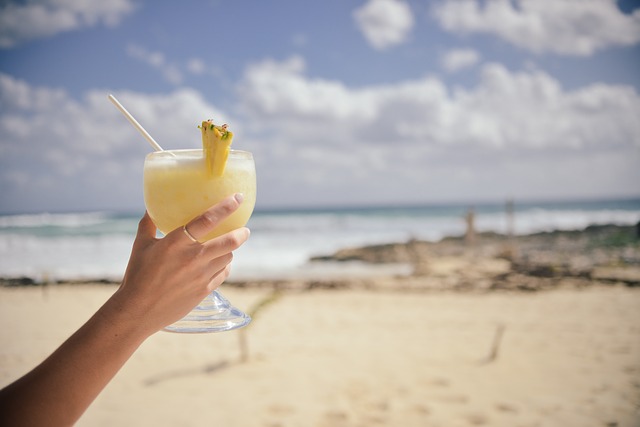If you were to go back a few years, people would laugh at the idea of a portable blender. But nowadays, with people being much more mobile and having to bring kitchen essential with them, it’s no joke.
There are lots of portable blenders on the market. And while I’m not someone who needs to use them, I have a lot of friends and colleagues who do.
So, after discussing the different aspects of portable blenders for a while now, I decided it was time to write a definitive blog guide that explains exactly how to use a portable blender and what to look for when choosing them.
The Basics: What Makes A Blender Portable
Ok, so before the introduction of USB blenders and battery powered blenders, the most common solution people had was to physically take their blenders with them.
Obviously you can see how this would be an issue. Especially if you own a large blender such as a Vitamix or some other big jar blender.
But it was done. People who worked on the road would have a travel case (there were even companies that would design special travel cases for big blenders). I would coach a lot of them. People who had traveling sales roles or management experts in consulting who flew to different corporate locations every month.
However, recently there is a whole new wave of people who want to take their blenders with them. The demo is much different. It’s people who are super health conscious and want to be able to take their own portable blenders with them and make their own smoothies.
One of the major concerns people have with buying smoothies outside of their normal place is that you never know the quality of the produce used.
Some places have peanut butter, but it’s not organic and sometimes it’s the sugar filled stuff that also has hydrogenated oil.
And then there is the whole issue with organic produce? If you want to blend organic berries, and you’re on the road for work or vacation then you might not find a good smoothie store that uses organic produce.
If you’re traveling to a major city like New York, then you can likely find a decent smoothie place. But even then it’s not ideal to have to go out and buy a smoothie. A lot of folks would prefer to make it in their hotel room.
The problem with making a smoothie in a hotel room is that blenders used to be large, loud, and cumbersome. So, most people would just make do with buying a smoothie from a local store.
But now you have small portable smoothie blenders, some of which run on a USB power source. They are small, portable, and perfect for people who are on vacation, travel, or even dorming at college.
Are Portable Blenders Safe?
Yes, portable blenders are safe. And that’s a big distinction between the modern portable blenders and the old fashioned approach where people would try and make regular blenders portable.
The big difference is that the new type of portable blender is actually designed to be portable.
Design. That’s the important word there.
The older blenders functioned perfectly well. Your top of the line Vitamix? Probably the best blender on the market. A large jar Ninja blender? A great blender. But neither is designed to be a portable blender.
The new portable blenders are designed to be taken on the road. They are smaller in design, and also feature easier power source requirements.
You’re mainly dealing with two prominent feature changes.
First, the power source is adapted and is now either battery or USB or small wire plug. It’s changed from large blenders where you are dealing with bulky wires.
Secondly, the blenders themselves are designed to be smaller. And that makes perfect sense.
When you are traveling, it only makes sense for things to be smaller so that they take up less room in luggage.
So, the modern portable blender is going to be smaller and have a more easy to use power source.
How Do You Use A Portable Blender?
Modern portable blenders are pretty straight forward and self explanatory.
For most people, you would likely be best using them to make a single serve smoothie. Simply because the portable blenders are smaller than your average at home blender.
Think of a portable blender as your regular blender, except it should only be used for protein shakes, berry smoothies and possibly some green smoothies with micro-greens.
You set it up, fill it up, blend, and you’re set.
The devices are all pretty similar. There is not different functions. The key difference is the power source.
I prefer to use a blender that does not require you to have a power source. Especially if I’m at someone’s home or an Air BnB. If you’re staying at a hotel, then it might be easier to use a power source for your blender.
Of course, the other benefit to a smaller blender is that if you are traveling, you can take the blender (without the blade) onto the airplane on carry on luggage.
Where Would You Use A Portable Blender?

The main use of a portable blender would be for outside recreation or travel.
Most of the people I speak to want to use a portable blender either for the beach, a backyard pool BBQ or party, or maybe travel.
The main areas I see as being prime for portable blender use are:
- Backyard Parties and Pool Parties
- Beach
- Picnics/Parks
- Camping
- Travel
The main reason you’d want to use a portable blender at these locations is to make frozen drinks. As a rule, I’m not someone who thinks it a good idea to try and make green smoothies at the beach (not really fun, plus most portable blenders that work at the beach won’t make them).
But if you’re keen on making healthy frozen drinks or even frozen drinks with booze, then there are some really cool ones to check out.
Battery or USB: Different Power Sources for Portable Blenders
There are two main ways you can power a portable blender.
First, there are battery powered blenders. These are for the true on the move person. They don’t require any plug.
The second type of portable blender is the type that uses a USB plug.
Let’s dive in.
Battery Powered Portable Blenders
Most travel blenders are not battery powered.
Read that again.
That’s right. When you do a search online for portable blenders, a lot of people are going to advertise them as being battery powered. But then read the fine print when you go to purchase them and you will see “short power cord” or “plug in anywhere”.
Basically, it’s very rare to find a cordless blender simply because blenders use a lot of energy.
That’s one reason why I was never a big fan of portable blenders. If you’re looking to blend up anything substantial (leafy greens, nuts, etc…) then a portable blender honestly isn’t that great an item.
However, there are people who really want a cordless battery operated blender. And for those guys and gals out there, I got you!
Here’s a nice list of blenders that are battery operated. Now, they might have a cord that you use to charge the blender, but that’s standard with any cordless appliance (drills, etc…).
Here’s a real portable cordless blender
A Cordless Stick Blender (why not?)
I’m also going to add in some cordless immersion stick blenders. These are great for people who are looking to do immersion blending. Although if you’re in a hotel or someone’s house, I don’t see the reason to have an immersion blender. These stick blenders are best for kitchen cooking and even soap making.
Back on Track–Another Cordless Blender, Bullet Style
Here is a nice bullet style blender that fits the target need.
The main advantage to the blenders in this category is that they are true cordless blenders in the spirt of the term. They can be operated without an outlet. However, you will have to charge them, as you would with most cordless appliances.
USB Powered- Portable Blenders Using a USB Cord
Here are where you will find most of the blenders that fall under the “portable blender” designation. These blenders are techically portable, but they do require a power source.
These blenders are great if you are someone who is comfortable with USB charging (phones, laptops, tablets, etc…) and don’t mind adding another item to the list.
Again, they aren’t as strong as
stand alone, regular plug into the wall blenders. But they will do the trick if you’re out somewhere and need to use a blender.
If you’re at the pool side or beach and want to make frozen drinks, for instance, then a small charging pack would suffice our an outlet for cell phone chargers.
Here’s a popular one for instance:
and one more
Honestly, my opinion on these blenders is that they aren’t for much besides frozen drinks and protein shakes. But they are so cheap that it’s not a worry if they break or get lost.
And that’s important. When you are traveling, you don’t need to be weighed down by the worry that you’re going to break or damage some really expensive item.
Battery or USB Portable Blenders: My Thoughts
My particular thoughts are as follows.
If you’re hitting the beach or a backyard pool party, and want to make frozen drinks, then go ahead and use a portable blender. It’s the perfect use for them.
However, if you’re traveling, and want to bring a blender along, remember that you are going to go light with your smoothies. Frozen drinks are one thing, but heavy duty blending is another. Interestingly enough the battery powered blenders are actually better at smoothies than the USB models.
All in all, I would recommend a portable blender for someone to use on special occasions only.
Related Posts

Hi Everyone!
Jenny O’Brien here. Nutritionist & personal trainer. Just your average vegetarian and smoothie fanatic!
If you have any questions, or you’d like me to cover a particular topic, drop me a line and let me know!
Thanks!






